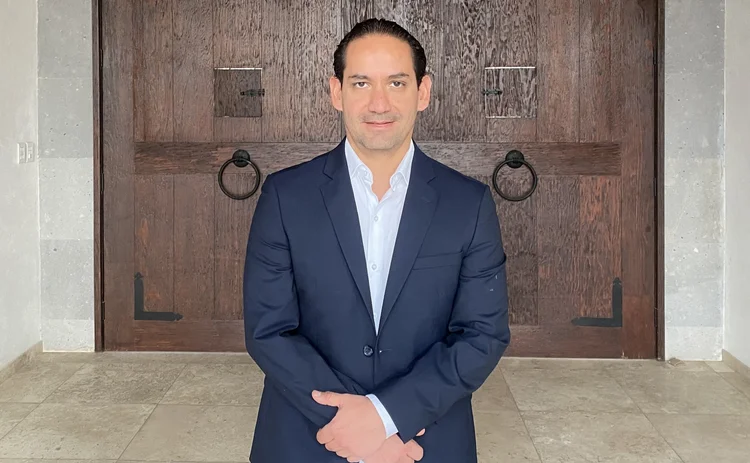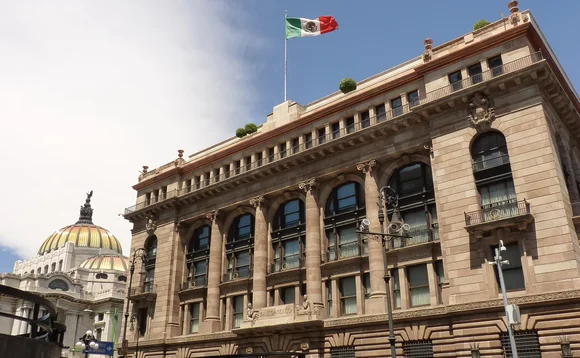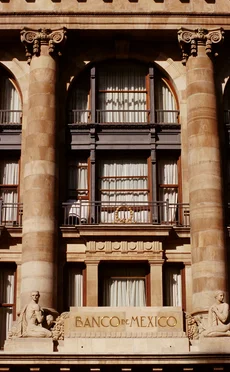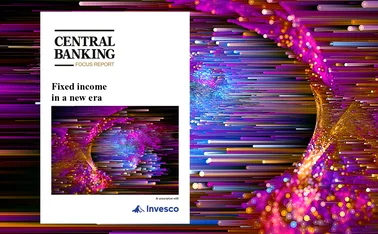Banxico's García on reserve risks: inflation, market volatility and war
Gerardo García, director general of central banking operations at Bank of Mexico, discusses fixed income, including US Treasury and mortgage-backed securities (MBS) dynamics, currency diversification, the value of external managers and his extensive use of derivatives, including USD/JPY basis trades.

What is your view of the current financial landscape?
Gerardo García: We are currently getting over a series of unprecedented events, starting with the Covid-19 pandemic, the massive fiscal and monetary stimulus to deal with it, very high inflation and – over the past two years – the rapid withdrawal of monetary stimuli.
At the same time, the world is moving away from a multi-decade trend towards economic integration and financial globalisation, which began after the Second World War. This can have long-lasting and unforeseen geopolitical implications.
All of this implies that the range of possible outcomes for the global economy and financial markets has become much broader. In effect, we are going through a very uncertain period, which calls not only for flexibility and agility as investors, but for humility around how much we think we know and understand about potential future developments.
Gerardo García is director general of central banking operations at Bank of Mexico (Banxico), where he is responsible for the implementation of monetary and exchange rate policy, and the investment of international reserves. Banxico is the financial agent of and adviser to the Mexican federal government, meaning García is responsible for conducting local debt issuance, executing foreign exchange transactions and implementing hedging programmes on its behalf. His former responsibilities include directing Banxico’s international operations division. García holds a master of business administration degree from Yale University and a bachelor of arts degree in economics from the Monterrey Institute of Technology and Higher Education.
What are Bank of Mexico’s (Banxico’s) most pressing reserve management objectives, and how have you prioritised liquidity, safety and returns in your reserve management strategy?
Gerardo García: For the past several years, Banxico has prioritised capital preservation – or safety – over return, always against a backdrop of a highly liquid portfolio. This has been especially important during the past couple of years, where most central banks have turned to highly restrictive monetary policy stances, increasing interest rates across the board, which has led to a reduction in financial asset prices.
This has also been relevant as the level of international reserves hasn’t increased significantly.
There was pressure on the Mexican peso a few years ago, leading Banxico to introduce a derivatives hedging programme to stabilise volatility. How well did the programme perform versus selling reserves? Why are you now unwinding the hedging programme and how is that being carried out?
Gerardo García: Since 2012, the process of accumulating international reserves has experienced a noticeable slowdown. This has primarily been due to a reduction in US dollar inflows from Mexico’s national oil company, Pemex, which used to be the most important source of reserve accumulation.
Starting in 2014, oil prices dropped significantly while, simultaneously, production from Pemex declined. We were producing around 2.6 million barrels per day at that time, and are now producing around 1.7 million barrels per day. Pemex is required by law to sell the dollars it obtains from oil income to Banxico. Pemex is also importing more gasoline, meaning its trade balance is in a deficit. Because it is not selling any more dollars to us, our main source of reserve accumulation came to a halt.
In response, we have adopted a more cautious approach to maintaining our reserve levels in line with internationally recognised reserve adequacy standards. At the same time, we aim to have the tools necessary to ensure the orderly functioning of our foreign exchange market.
Through detailed analysis, we determined that a derivatives hedging programme would positively complement the policy toolkit for FX interventions. A key factor in the programme’s success is the well-developed and liquid nature of the Mexican peso derivatives market, enabling it to affect the spot market effectively. Furthermore, this programme allows us to intervene in our FX market to maintain or re-establish its orderly functioning without, in general, reducing the stock of international reserves.
We are currently unwinding the programme, as operating conditions have reverted to appropriate levels of liquidity and depth. The market is operating in an orderly fashion against a backdrop of strong fundamentals in the Mexican economy. The Mexican peso is the third-most-traded emerging market currency after the Chinese renminbi and Indian rupee. Consequently, financial institutions and other economic agents now have the means to hedge FX risks directly in the FX market. In short, we are reducing the size of the programme gradually, ensuring the market continues to function in an
orderly fashion.
It is worth emphasising that the hedging programme is part of a broader policy toolkit that includes potential interventions in the spot market, and the use of other derivatives, including swaps and options. It is important to highlight that the characteristics of the intervention, including the instruments to be used, depend on the specific dynamics and needs of FX markets at the time. If deemed necessary, we could use the non-deliverable forwards hedging programme, but we could use other instruments as well.
We use short-duration positions to capture the higher-for-longer nature of central bank decisions, and economic growth differential strategies to increase the exposure in currencies with the highest growth expectations and short those with projected weaker growth
How do you view the current economic outlook for the US? Are interest rates close to their terminal rates? Will rates remain higher for longer? And what is your base case for rates over the next two to five years – do you expect a ‘soft landing’?
Gerardo García: I have been positively surprised by the resilience of the US economy, particularly the labour market. Nevertheless, the most likely scenario is for the US economy to slow down gradually as the effects of tighter financial conditions work through it, as consumers deplete their savings from the pandemic policy responses, and as households’ and companies’ balance sheets feel the higher costs of refinancing debts. Labour strikes and the possibility of a government shutdown also add to short-term risks. Even in this scenario, the US Federal Reserve will likely keep its rates high for the next few months – as inflation is still far from its objective of 2% and upside risks prevail, such as higher oil prices and wage pressures. Even this scenario calls for higher-for-longer interest rates.
Recession is a less likely scenario because of the strength of the labour market, which will continue to support consumption. I also think the manufacturing sector could benefit from a new structure of supply chains. So, if recession materialises, it would probably be mild. Finally, a left-tail scenario is one of persistent inflation and above central banks’ targets for a longer period than expected. I believe, in most advanced economies – including that of the US – central banks’ reaction functions are the ones that would push forward the dates that interest rates would be cut, but not increase interest rates much further as ex ante real rates are already high.
In any case, I think short-term interest rates will remain high as long as needed to get inflation under control. Long-term rates may also remain high, largely as there are a few factors pointing towards a higher ‘term premium’ – including debt stress and quantitative tightening – and the expectation of higher interest rates in the medium term.
What is driving the rise in long-term interest rates?
Gerardo García: While it is challenging to pinpoint a definite set of factors, I will underscore the following.
First, the expectation of higher-for-longer interest rates is based on the economic resilience of many advanced and emerging market economies, and inflation being stickier than anticipated.
On the one hand, the significant increase in US Treasury issuance is putting pressure on long-term interest rates. On the other, demand has not compensated for the prominent shift in supply. Demand for US Treasury bonds also seems more elastic, which adversely affects demand for duration. In other words, demand for longer-term bonds is falling relative to shorter-term bonds, putting upwards pressure on the yield slope.
If the medium- and long-term outlooks of growth and inflation are more uncertain, one would expect higher interest rate volatility. Investors might therefore require greater compensation for bearing long-term interest rate risk.
Quantitative tightening programmes continue their paths in advanced economies, adding to the pressure on longer-term rates. Before, we had quantitative easing programmes and central banks buying bonds significantly, which compressed term premia. Now that they are unwinding such programmes – that is, implementing quantitative tightening – the term premium will probably increase again. I think this is also affecting long-term yields.
There is also some uncertainty around and concern about the marginal buyer of US Treasuries. Previously, countries such as China and Russia bought a significant amount of US Treasuries, which helped keep long-term rates down.
Today’s outlook is different. Going forward, other factors – such as increasing interest rates in some financial markets, such as Japan – could attract bond flows towards those markets and away from the US bond market. This would contribute to lower demand for US bonds, putting more pressure on interest rates.
Except for the first point, the combination of these elements is reflected in an increase in the term premium, which can be understood as the compensation that holders of long-term bonds demand. Thus, it includes all risks that are priced in for such bondholders, including inflation risk and liquidity risk.

Have there been structural changes that might lead to higher interest rates?
Gerardo García: The current economic scenario calls for short-term interest rates to be higher than they used to be. Think of how well the US economy is doing and how the labour market is performing, despite the Fed having increased interest rates significantly since 2022. This suggests interest rates in the US could be higher than before, but how much higher is a very difficult question to answer. There are a few reasons interest rates could be higher. One is cyclical in nature and has to do with the US economy growing above its potential, with a positive output gap that reflects the unprecedented fiscal stimulus that has been prevalent since the pandemic.
A second point that is more structural in nature and relates to higher debt burdens in the US and other economies: the expectation of larger fiscal deficits and higher debt issuance point towards higher interest rates going forward.
There are other structural factors that could result in higher rates. For instance, labour force participation rates remain lower than pre-pandemic levels in many countries, which might result in tight labour markets; or the ageing of populations in some advanced economies will probably reverse a long-term trend of savings – the savings glut – into consumption, pushing interest rates up. The restructuring of global supply chains might result in many investment opportunities in several countries. More generally, technological innovations – such as artificial intelligence – could positively impact productivity. These factors have called the secular stagnation hypothesis into question.
Finally, from a financial markets perspective, many market indicators are already suggesting interest rates will remain high for a long time. For instance, long-term forward rates that have moved away from the lower-for-longer thesis – which has prevailed since the global financial crisis that begain in 2007–08 – and are now pricing a higher-for-longer scenario.
The way we think of tactical asset allocation is that we want to generate consistent returns above the benchmark – and that comes from many, small systematic trades
Given generalised market losses on equities and fixed income in 2022, and a shift in geopolitics, interest rates and inflation dynamics, has Banxico reassessed the diversity of its investments?
Gerardo García: Central bank portfolios are not that balanced in the sense that most of our portfolios benefit from low-growth and low-inflation scenarios, but suffer in higher-inflation and higher-growth environments. Therefore, in recent years, it has become more important to increase the flexibility of investments to adjust to market conditions.
We are constantly trying to enhance the diversification of our portfolio by adding new asset classes such as floating-rate notes and inflation-protected bonds in different currencies. We are also active in derivatives that can help us hedge interest rate risk. We constantly enhance the diversification of the portfolio by incorporating currencies of countries whose economic cycles and monetary policies are negatively correlated to those of the US. We are also developing approaches that benefit from rising interest rates, such as total return strategies.
Evidently, portfolio management becomes more challenging in periods such as the one seen in 2022, where historical correlations break down and most asset classes’ prices move down in tandem.
Which countries offer this kind of diversification?
Gerardo García: There aren’t many. I think the most important one, considering reserve currencies, is the renminbi. Some other Asian currencies also exhibit low correlations to the rest of our reserve portfolio – thus, it is mostly Asia. Traditional reserve currencies – such as the euro, sterling and Swiss franc – tend to exhibit higher correlations with the most important asset in our portfolio: US Treasuries.
When might most of the world return to lower interest rate environments?
Gerardo García: That’s a very tough question. It’s like trying to forecast the length of business cycles. Today we are in a phase of the cycle that is still expanding, and have been pushing forward the expectation for a slowdown. Why? Think of the US economy: it has proven very resilient. In this case, monetary policy has taken longer to affect it. This time around, the monetary policy lag has been larger because households and corporations emerged from the pandemic with healthy balance sheets.
However, I’m certain that, at some point, we will experience a slowdown, and today’s expectation of having higher interest rates for longer does not mean higher forever. So, eventually, I think interest rates will come down. When we start to see a slowdown and have more clarity into what advanced economies will do with regard to monetary policy, fixed income assets will offer some value for global investors.
We are constantly trying to enhance the diversification of our portfolio by adding new asset classes such as floating-rate notes and inflation-protected bonds in different currencies. We are also active in derivatives that can help us hedge interest rate risk
How is Banxico preparing for future shocks?
Gerardo García: This requires a diversified portfolio. When you think of diversification, most people only think of asset classes, which is a narrow view of diversification. We focus on asset classes, but also on risk factors. When I say risk factors, I mean focusing on interest rate risk, but also currency risk, credit risk and liquidity risk, for example.
We also try to have a portfolio that performs relatively well under different economic regimes. Because most central bank portfolios are heavily skewed towards fixed income assets, when you have higher economic growth and higher inflation, interest rates go up and the value of bonds goes down. So, if you mark-to-market your portfolio, you will have losses. In 2022, even the more diversified portfolios, such as those that combined fixed income with equity, because equity has become more important for some central banks – is that interest rates went up and equity prices came down. Correlations broke down. That was a very different – and very difficult – scenario for investment portfolios.
What is the current status of the review of Banxico’s strategic asset allocation (SAA) and its customised benchmarking?
Gerardo García: Our SAA is a continuous process. Its core principle relies on extracting expected returns using market-based information, meaning we derive expected returns, for example, in fixed income assets based on the current structure of the yield curve, and currency returns from option prices.
Our investment horizon is one year, but we constantly review our SAA methodology to ensure it remains fit for purpose. For example, we constantly analyse new asset classes to enhance the diversification for our portfolio, and evaluate whether our optimisation algorithm results are consistent with our investment objectives – be they enhancing return or preserving capital. In other words, we ask ourselves whether the results really make sense. We assess whether the performance of the portfolio is in line with the forecasted return or if fine-tunings in the methodology are warranted.
How did Banxico build the optimisation algorithm and what factors go into it?
Gerardo García: We started a few years ago. Prior to this, the inputs for our SAA were based on historical data. And then there was the point at which we reached very low levels of interest rates and the questions were: ‘Should we rely on history, which is telling us interest rates have gone down significantly?’ and ‘Are we saying interest rates can go even lower?’ We thought this was probably not the way to go.
So, how could we build a forward-looking portfolio? At first, we used analyst expectations and our own forecasts. The board was asking: ‘Why should we believe you or an analyst?’ We then came up with the idea that you can believe markets are in some way efficient and you can derive what the expected returns are from market prices. That’s the whole idea and concept behind our SAA.
We derive the expected return on bonds from yield curves, and we derive from FX options the expected distribution of returns of currencies. We then merge those expected outcomes from currencies and fixed income and come up with a joint distribution of the expected return for each asset. Then we work with the correlations and come up with a portfolio built from inputs that are coming directly from the market.
The way we build the portfolio is very objective. You can argue that markets are not always right and we are building our portfolio from market prices, which is correct, but it’s an objective way to build an SAA, long-term portfolio. If we think the market is not right, we can use tactical asset allocation (TAA) or tactical deviations to adjust the portfolio to the scenario that, as portfolio managers, we believe will more likely materialise.
We have identified that diversification benefits can be enhanced by investing directly in the fixed income markets of each currency, rather than exclusively focusing on the currency itself. This has proven effective – primarily due to the relation between FX and interest rates
How has the composition of Banxico’s fixed income holdings changed since 2021 in terms of share, type, currency and duration?
Gerardo García: Our SAA is revised on an annual basis. Since 2021, the most relevant adjustments to our SAA have been a decrease in exposure to US Treasury nominal bonds, US agencies and European sovereign bonds, and an increase in allocation to Treasury inflation-protected securities and money-market instruments. These changes reflected the expectation of higher inflation and higher interest rates.
The currency composition of our portfolio has not changed noticeably. Most is invested in US dollars, as it is the reserve currency. Our non-US dollar exposure actually has decreased marginally, and we prefer to allocate to non-traditional reserve currencies, such as renminbi or Singapore dollar, as diversification benefits are larger.
In terms of risk factors, the portfolio’s duration has remained largely unchanged for around a year and a half since 2021. Its duration was two years before the pandemic. Our duration is very conservative – some central banks have much longer durations. Our duration has pretty much always been between a year and a quarter and two and a half years. The longer duration in place, the more interest rate risk you bear. Central banks are very conservative and most of them have a duration of around two years or so in their portfolios.
Finally, overall, exposure to spread products has decreased slightly because of a reduced issuance of eligible instruments in the US agencies market. Going forward, it is expected that a potential slowdown in economic activity and a decrease in inflation should have a positive impact on reserves’ returns, absent other market shocks. In this regard, we expect mild adjustments in our SAA. My expectation is that we will slightly increase the duration of the portfolio, but will maintain a conservative risk profile.

How do you assess the interplay between increased government debt, quantitative tightening and bouts of illiquidity in key reserve currency bond markets – particularly the US?
Gerardo García: The combination of increased government debt issuance and quantitative tightening add to the possibility of having higher long-term rates going forward. Most asset purchase programmes compressed term premia, so it is natural to expect a decompression as central banks’ balance sheet reduction continues to run its course.
Fixed income markets have seen bouts of illiquidity but I don’t think it’s a new phenomenon. In effect, the intermediation capacity of banks, dealers and market-makers has shrunk since the financial crisis, which is largely attributed to regulatory changes implemented in its aftermath. They reduced operations in some markets – one of which has been the US Treasury market – and, as such, liquidity has been shrinking for years. This is visible in some of the flash crashes. The first one was in 2015 in the US Treasury market, which was very significant. But liquidity also dried up at the beginning of the pandemic, and this type of abrupt movement has been seen in some currencies.
I think this speaks about the lower intermediation capacity of market-makers and some new participants. When you need liquidity, they basically withdraw from the market. Moreover, when you think of high-frequency trading or proprietary trading firms, they are not liquidity providers at the precise time you need them to be.
This means that, previously, you could probably do larger trades and nowadays you have to do smaller trades, most likely with a larger number of counterparties, which are more specialised in a particular market, currency or asset class.
The problem today is that such lower intermediation capacity is at odds with the larger needs of issuance and the refinancing of various governments, including the US. When you consider all risks the global economy faces, you realise markets can turn more volatile going forward. Some implied volatility indicators are clearly pointing in that direction.
Bond markets are currently experiencing volatility – what significance does that have for Banxico and for reserve managers in your region?
Gerardo García: We will experience high volatility going forward because we are facing a very uncertain scenario – starting with inflation. Are we certain inflation is going to be around central bank targets a year from now, in most cases? I’m not sure.
Possible risks are oil prices, which have increased significantly over the past three months. If there is uncertainty around inflation, there will be uncertainty around how central banks will move forward. The expectation is for most advanced economies’ central banks to stop at these levels and reduce interest rates in the next few months, but that will be subject to potential changes with inflation.
That uncertainty around inflation and central banks’ policy movements is reflected in uncertainty in financial markets and higher volatility. Current geopolitical situations – wars in eastern Europe and the Middle East – add to this scenario of higher volatility going forward.
What are the pros and cons of inflation-protected bond products, their derivatives and how Banxico has used them? Is there a role for gold?
Gerardo García: I believe inflation-protected bonds offer value in higher-inflation scenarios – particularly when you think of them in relative terms against nominal bonds. But these instruments also have interest rate risk so, in an environment where real interest rates have increased, investors are likely to incur significant losses.
Furthermore, investors must recognise these instruments are less liquid, so building or unwinding a position can take longer. We don’t use derivatives on inflation, so I don’t have anything to add in this regard.
Shifting our focus to gold, we have observed that its appeal for hedging against inflation has waned. High interest rates are negatively correlated to gold prices. Gold plays a more significant role as a safe-haven asset, and becomes particularly vital during episodes of financial stress, such as those seen in today’s difficult geopolitical context.
You have previously discussed the ‘cost of carry’ many central banks face. What are the most important issues reserve managers should consider in this area in the current environment?
Gerardo García: We have addressed this problem by enhancing the return profile of our portfolio while safeguarding liquidity and capital preservation in our decision-making processes. One way to achieve this is by finding additional sources of diversification to reduce the gap in interest rate differentials.
In Mexico, the nominal interest rate is currently 11.25%. In the US, our most important market, where the two‑year note, for example – which most closely resembles the duration of our portfolio – the interest rate is around 5.25%.
Hence, there is a differential of 6% that we are paying on our liability side, and less than 5.25% that we are earning on our asset side. So that 6% interest rate differential basically reflects the cost of carry. To reduce that cost of carry you can try to enhance the yield of your portfolio by, for example, switching a little bit away from Treasuries into, for example, agencies or supranationals or corporates, which will give you a higher yield than the 5.25% of the two‑year note. There are credit components you can use to try to reduce that gap, obviously, within our risk parameters and risk tolerance.
We have also tried some systematic yield enhancers, such as our synthetic investments in US dollars, which take advantage of the FX basis in FX derivatives markets. Instead of having US Treasury bills, which could be a large part of our portfolio, we could sell those US Treasury bills and receive dollars, lend those dollars out into the swaps market and hedge that back. For example, we lend those dollars out, exchanging them from dollars to Japanese yen, which is the typical strategy we use. We then invest those yen in short-term bonds in Japan.
To avoid FX risk, we hedge that FX risk back to the US dollar. So we end up with a higher US dollar rate than the one we began with in US Treasury bills. You can do that with a large proportion of the portfolio. and then you will have some yield enhancement without FX risk and you vary the credit risk component by switching from US Treasury bills into Japanese bills.
That’s a very common strategy many are taking advantage of because covered interest rate parity is not holding at this point. So, basically, lending dollars out into the swap market allows you to build strategies that are yield enhancers.
It’s important to emphasise that, while we seek to minimise the cost of carry, our primary objective remains maintaining reserves at adequate levels. In this regard, closing the gap is not necessarily the highest priority.
There is some uncertainty around and concern about the marginal buyer of US Treasuries. Previously, countries such as China and Russia bought a significant amount of US Treasuries, which helped keep long-term rates down
How are these kinds of tactical trades executed?
Gerardo García: The money-market desk is continuously seeking to allocate the most liquid part of the international reserves portfolio in the highest-yielding alternative, subject to our risk constraints. In this regard, they compare, among cash accounts: time deposits in US dollars, other money-market instruments in US dollars and the synthetic investments in US dollars previously described. For some years now we have found one of our best alternatives to be in the Japanese markets. The process involves all three desks in our organisational setup. The US dollar fixed income desk will most likely compare all US dollar domestic rates against US dollar synthetic rates. If synthetic rates are higher, they will co‑ordinate with the FX desk to engage in a swap transaction to lend US dollars in the swaps market, and invest in a non-US dollar short-term money-market instrument, most often in yen.
In what other ways has Banxico engaged in tactical trading, and what opportunities are you currently considering?
Gerardo García: We implement different strategies to establish our tactical positions. We have tried to make these strategies more systematic and analytics based. For example, we use a dynamic optimisation process that consists of using a similar methodology that we use for our SAA, but with a shorter timeframe. Every three months, we look at what market prices might be telling us about the future and invest accordingly. In a way, we reposition our portfolio based on the most current information and market conditions. The results so far have been positive.
We also trade the futures’ bases, which means we sometimes use derivatives to adjust the duration of the portfolio and use the cash proceeds to invest in shorter-term securities that offer higher yields. Our carry strategies in FX markets imply we short currencies with the lowest carry and go long in those with the highest. We use this strategy only under low FX volatility regimes.
Other strategies are informed by market views that are a result of our macroeconomic analysis. We use short-duration positions to capture the higher-for-longer nature of central bank decisions, and economic growth differential strategies to increase the exposure in currencies with the highest growth expectations and short those with projected weaker growth. Assessing economic growth differentials, we look at the juncture of what’s happening with the global economy right now, as opposed to a long-term view or an optimal portfolio.
The way we think of TAA is that we want to generate consistent returns above the benchmark – and that comes from many small systematic trades. Our TAA is often compared to that of our external asset managers. The way I think of this competition is that we are often the steady tortoise that beats the hare. You have to do tens – perhaps hundreds – of small trades in which you will pick up a little bit of extra alpha as opposed to having these very big trades that will earn you a lot of money and that some asset managers are taking in terms of large deviations in duration or in currencies. Sometimes they do it right, but sometimes the strategy can go wrong. We are very conservative in deviating in duration or FX, but are making small tweaks that will earn a little bit in a very consistent way.
You mentioned Banxico had added exposure to Asian currencies as you believed Asian economies offered the greatest diversification benefits – are you continuing to increase exposures to these currencies and, if so, how?
Gerardo García: We have increased exposure to Asian currencies since 2019, and has not changed much since then. We did so because of the low correlation these currencies hold with other traditional reserve assets. Our SAA model tends to allocate more resources to Asian currencies, so we have to impose some exogenous restrictions on our optimal allocation.
It is also important to mention we have identified that diversification benefits can be enhanced by investing directly in the fixed income markets of each currency, rather than exclusively focusing on the currency itself. This has proven effective – primarily due to the relation between FX and interest rates, which serves to amplify the diversification benefits when investing in other currencies. As such, we’ve chosen to implement these investments in the Asian fixed income markets rather than solely in short-term instruments.
Many central banks consider Latin American investments attractive because of the perception that the inflation cycle has peaked. Many also now consider Indian rupee investments more attractive than renminbi, despite the latter’s reserve currency status. What is your view?
Gerardo García: In our ongoing pursuit of portfolio diversification and improvements to the risk/return profile of our investments, we continuously evaluate new currencies and assets. However, our exploration is somewhat constrained by limitations related to credit ratings. In particular, India’s credit rating currently falls below our established minimum credit rating threshold, preventing us from considering investments in this particular currency. This situation also applies to other assets in Latin America, as they typically do not meet our minimum credit rating requirements.
However, some central banks have more leeway to invest in lower credit-rated instruments. For those, Latin American fixed income markets, including Mexico’s, might present attractive investment opportunities, as interest rate differentials are wide, inflation has peaked in most cases and central banks are starting to cut interest rates. Moreover, many of these countries have done their homework and have strong economic fundamentals. So I believe the outlook is favourable.
Having said that, capital inflows to emerging economies will materialise when investors receive more clarity on whether advanced economies’ central banks are finished with their tightening cycles, and when they observe lower volatility in financial markets and there is more certainty around long-term rates. Investors will also seek relief in terms of the various risk factors that currently affect the global economy – geopolitical conflicts being the most obvious.
What climate-related investments does Banxico’s reserve management department engage in and how is this likely to change over the next five years? If you engage in green investments, what are the best approaches to ensuring sufficient liquidity while avoiding the risk of greenwashing?
Gerardo García: Our journey towards sustainable and responsible investments began with the acquisition of bonds issued by supranational organisations aligned with these principles. In 2016, we took the first step in this direction by entering the green bond market. Since then, the list of eligible issuers of sustainable/green bonds has grown significantly.
Another strategy we have implemented is negative screening to exclude securities that do not align with our fundamental values. Such values promote development, prosperity and ethical conduct. Additionally, we promote highly responsible investment standards with our external asset managers.
Throughout this journey, we’ve come across several challenges, including the limited secondary market liquidity of green, sustainable or social impact bonds. There is also the constraint of limited environmental, social and governance (ESG) government debt issuance; heterogeneity of ESG criteria; an absence of ESG ratings for a broad spectrum of securities; and disparities in reporting standards and performance metrics, among other complexities. Furthermore, investing in green bonds might sometimes be at odds with other reserve management objectives, such as liquidity and return.
Consequently, we have refrained from establishing an explicit ESG threshold or specific sustainability objective for our investment portfolio – our exposure has not grown much, to be honest. But we are very aware of the urgent need to promote an energy transition, and sustainable and responsible investments, and are working with the Network for Greening the Financial System and other supervisory and regulatory bodies to address some of these issues, and possibly have a larger impact going forward.
We hope that, in the years ahead, these markets will continue to expand, and an increasing number of entities and companies will align with sustainable and responsible investment practices. As this alignment grows, we anticipate the challenges we’ve encountered previously may be gradually resolved. This will possibly enable us to further enhance our involvement in these markets.
Covered interest rate parity is not holding at this point
How does Banxico use external asset managers and data providers to support reserve management at strategic, tactical and other levels?
Gerardo García: Since its inception in 2001, our external asset management programme has grown significantly. This has been not only in terms of assets under management, but also in investment in new financial markets, and expansion of high-level discussions and knowledge transfer. The programme represents an integral aspect of our reserve management strategy and plays a crucial role in meeting our needs through our partnerships with external professional managers.
The programme began with the objective to build up credibility on our investment decisions by comparing the performance between internal staff and managers. In other words, to serve as a live benchmark. Moreover, another relevant goal of the programme has been to enhance the performance of the investment portfolio, as external managers are expected to outperform the benchmark portfolios.

Simultaneously, we have aimed to leverage the knowledge and technology transfer from external managers. We have successfully achieved this through various strategic initiatives that have bolstered our investment process through regular calls and meetings to discuss market outlooks and portfolio positioning, research and investment idea sharing, seminars on specific topics with other clients and tailor-made training in-house and externally. This has provided us with a constant flow of ideas that is used to complement our decision-making process with additional viewpoints. These providers are also useful when we want to delve into a particular topic in which we don’t have much experience.
As our FX reserve portfolio experienced a pronounced increase in size from 2007–15, the external asset management programme was and continues to be a source of relevant ideas for diversification in new asset classes and investment strategies, whether in fixed income, currencies or derivatives. Since 2015, the programme has been used to gain exposure to asset classes, such as MBS and corporate debt, which are operationally complex and would require significant human and capital investment. The incorporation of these asset classes as part of our investable universe has further strengthened the diversification process.
What results have you seen investing in MBS and corporate debt?
Gerardo García: The results have been positive because we have been getting the credit risk premium you can get with those types of securities. So we are harvesting that risk premium. When I mentioned the current cost of the reserve portfolio, I said there were some ways to reduce the carry cost, and MBS and corporates both trade at higher yields than US Treasuries.
There are times these portfolios have performed very well, and other times they have underperformed Treasuries. So, at this juncture, for example, there have been some concerns about the housing market in the US, and the Fed has been shrinking its balance sheet and participating less in the MBS market. Some of the spreads of MBS against US Treasuries have widened somewhat. In any case, if you look at this portfolio from a long-term perspective, it has been a very good addition to the portfolio. The same can be said about our corporate debt exposure.
In view of the limits on FX reserves portfolios – such as the restriction to invest in securities with a high-risk profile – we expanded our external asset management programme by adding a non-benchmark mandate. Its rationale was to provide more flexibility and to increase the benefits of diversification, preserving capital regardless of the prevailing stage of the business cycle. Its results have been successful, yielding valuable insights that have positively influenced the overall investment process and further diversified the portfolio. Since its establishment, the non-benchmark mandate has contributed to the creation of portfolios exhibiting low or even negative correlation with our internal investments. Thus, it has effectively fulfilled its objective of enhancing the entire reserve’s investment strategy.
The success of our external asset management programme hinges on continuous evaluation, ensuring all of its aspects align with our objectives. We expect the programme to continue evolving with our asset management process, adapting in ways that seize its added value, not only in terms of returns, but in portfolio diversification, and knowledge and technology transfer.
What risk measures does Banxico employ when implementing strategic and tactical investments, and how have they changed in the past three years?
Gerardo García: In general, for the international reserves portfolio, we have certain risk limits, such as a minimum amount in liquid assets – a universe of eligible assets that is broad but still conservative, and a minimum credit rating.
More specifically, in terms of SAA, we now have a minimum conditional value-at-risk (VAR) objective function, which is aligned with our investment objective of capital preservation. However, in terms of monitoring the benchmark portfolio, we also consider risk measures such as VAR. Additionally, we keep track of the balance of the portfolio’s sources and risks such as credit, interest rate and currency.
In terms of TAA for active management, we have a risk tolerance for the positioning in terms of excess VAR versus the benchmark portfolio. When defining the magnitude of deviations, we consider metrics such as DV01 and the options’ delta. DV01 assesses the sensibility of an investment by looking at how much it will earn or lose for every basis-point movement in interest rate. The delta of the options offers the sensibility of how the option price will move when the price of the underlying asset moves. We define profit-and-loss levels for TAA decisions. These measures and limits haven’t changed much in the past three years, but the deviations have become more conservative, given the liquidity and volatility of financial markets and the uncertainty of geopolitical and macroeconomic dynamics.
Geopolitical risks remain heightened. How do you factor these risks into Banxico’s reserve management?
Gerardo García: I wouldn’t like to speak lightly about geopolitical risks. First and foremost, some of the geopolitical tensions that have affected markets in the past couple of years are human tragedies. They demonstrate the unwillingness of opposing parties to talk and come to agreements, which I find extremely unfortunate and worrisome, particularly because I believe the move towards deglobalisation, nationalism and populism is a dangerous trend that will prove difficult to contain.
Factoring geopolitical risk into any type of model is difficult. If we learnt anything during the pandemic it is that economic models cannot capture unprecedented events, and geopolitical shocks fall into that category. I think the answer to this more uncertain future lies in having a well-diversified portfolio. When I think of diversification, I’m not only thinking of asset classes, but also risk factors, economic regimes and investment strategies.
One aspect of our SAA methodology that is helpful and that guides our decision-making is market prices. These are the main inputs of our SAA: they already incorporate rising geopolitical risk, mainly by having wider distributions of expected returns, or clear skews on those distributions – think of safe-haven assets having fatter right tails. In these circumstances, incorporating stress-testing and scenario analysis to the analysis of the portfolio might prove relevant and insightful. And being ready to take tactical decisions or active management strategies to adjust and protect the portfolio is of the essence.
Do you have any concluding thoughts?
Gerardo García: These are turbulent times. What is happening in financial markets is calling for investors to have the flexibility, adaptability and agility to respond to new and unexpected developments. An uncertain future awaits and, as ongoing processes continue unfolding, investors need to adapt swiftly.
More broadly, what is happening in the world calls for dialogue, openness, tolerance and empathy. The world needs to embrace the values of international co‑operation and peace. Of course, these are times in which co‑operation is much more challenging to achieve, but in many ways it is more needed.
The opinions expressed in this article are personal and do not necessarily reflect those of Bank of Mexico or its board of governors
Only users who have a paid subscription or are part of a corporate subscription are able to print or copy content.
To access these options, along with all other subscription benefits, please contact info@centralbanking.com or view our subscription options here: http://subscriptions.centralbanking.com/subscribe
You are currently unable to print this content. Please contact info@centralbanking.com to find out more.
You are currently unable to copy this content. Please contact info@centralbanking.com to find out more.
Copyright Infopro Digital Limited. All rights reserved.
You may share this content using our article tools. Printing this content is for the sole use of the Authorised User (named subscriber), as outlined in our terms and conditions - https://www.infopro-insight.com/terms-conditions/insight-subscriptions/
If you would like to purchase additional rights please email info@centralbanking.com
Copyright Infopro Digital Limited. All rights reserved.
You may share this content using our article tools. Copying this content is for the sole use of the Authorised User (named subscriber), as outlined in our terms and conditions - https://www.infopro-insight.com/terms-conditions/insight-subscriptions/
If you would like to purchase additional rights please email info@centralbanking.com
Most read
- ECB says iPhone is currently incompatible with digital euro
- Supervisors grapple with the smaller bank dilemma
- ‘Do I die, or do I survive?’ Officials reflect on Basel III complexity






